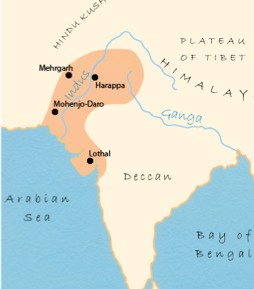Sign up for FlowVella
Sign up with FacebookAlready have an account? Sign in now
By registering you are agreeing to our
Terms of Service
Loading Flow


Indus River Valley Civilization

Mohenjo-Daro and Harappa are believed to be the twin capitals of the Indus civilization. A well thought out feature of Mohenjo-Daro was its grid patterned roads. Harappa and other Indus sites were often constructed with mud and unbaked bricks. Indus homes also had a plumbing and sewer system.


About 2600 B.C.-1900 B.C.

Mohenjo-Daro and Harappa
Geography
The three main geographical features of the Indian subcontinent are the Gangetic Plains, the Deccan Plateau, and the coastal plains to the west and east of the Deccan. The Gangetic Plains are fertile because of the Ganges and Brahmaputra Rivers distributing water over the region.
In the 1920s, the Indus civilization was discovered. It was the earliest South Asian civilization and came about in the Indus River Valley around 2600 B.C. Archeologists have investigated many sites, but have not yet discovered important documents to give information that may include the names of rulers, literature, or accounts of battles.
The Indus people made a living by farming and trading. They domesticated animals and developed an irrigation system. They may have been the first people to use the cotton they grew to make cloth. Indus vessels traveled up the Persian Gulf to places including Sumer. The Sumerians were thought to have given the Indus people the idea of a writing system.
The Indus religion was polytheistic. They had a mother goddess and held certain animals, like the buffalo and the bull, sacred.

What happened to the Indus civilization?
For uncertain reasons, the Indus civilization's quality of life declined around 1900 B.C. The use of writing was dwindled, Mohenjo-Daro was abandoned, and the population went very low.
One theory is that some sort of damage was done to the surrounding natural resources, perhaps the cutting down of too many trees. A major flood may have caused it as well; huge amounts of river mud have been found in Mohenjo-Daro. Another cause could have been a destructive earthquake.
Agriculture depended on the monsoons. Winter monsoons from the northeast brought hot, dry air harmful to the crops. Then in the summer, monsoons from the southwest brought moist air.